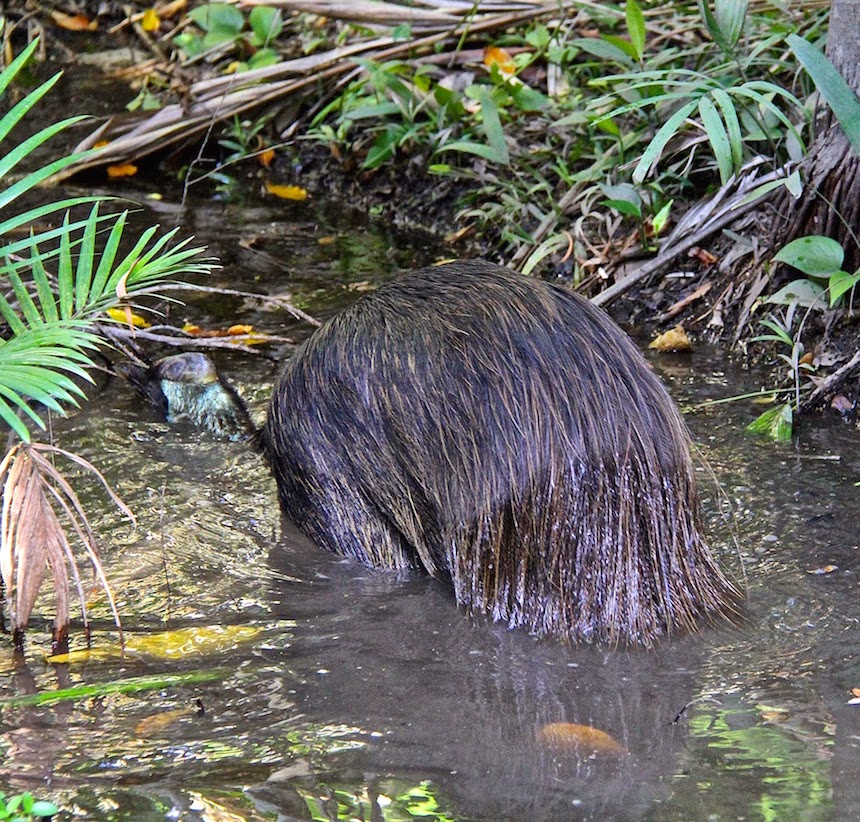Ex TC Marcia has returned to her place of birth and a worrying broad area of low pressure extends along Queensland's northern coastline, with barely a wisp of breeze to rattle a leaf. The day-time temperatures are again around 36 degrees dropping to 25 at night.
To cool off subadult cassowary Ky, every day this week, has been sitting in the pond for hours on end. There is a ready supply of food close by and he can venture off to eat within 50 metres of the pond then go back in the water to cool down.
 Subadult cassowary Ky sits absolutely still in the water through-out the heat of the day. The only movement to gain his attention is the plop of palm seeds falling.
Subadult cassowary Ky sits absolutely still in the water through-out the heat of the day. The only movement to gain his attention is the plop of palm seeds falling.  Ky occasionally ducks his head under the water.
Ky occasionally ducks his head under the water. He ventures out to feed on palm seeds before going back to the water, Ky should have been called 'Ducky'.
Every week there are changes on Ky's growing casque and wattles. His colours are developing strongly and only pin-feathers remain on his neck.
 Meanwhile, Snout and Jessie turned up on Tuesday still courting. I was driving in the back entrance when in front of me, beside the road, I saw Jessie sitting with Snout beside her. I did not want to drive past them so I stopped the car, ran down to the nursery, loaded up with mosquito repellent and around and back up the road in front of them. With the sun now behind me it was easier to photograph.
Meanwhile, Snout and Jessie turned up on Tuesday still courting. I was driving in the back entrance when in front of me, beside the road, I saw Jessie sitting with Snout beside her. I did not want to drive past them so I stopped the car, ran down to the nursery, loaded up with mosquito repellent and around and back up the road in front of them. With the sun now behind me it was easier to photograph.
It took around five minutes for me to run down, around and back and by then Jessie was standing up and grooming.


Jessie had a good shake. Then Snout turned to her as if to say," Ready now girl, let's go".

 They reached the car and Snout stopped. Jessie took one hard look and walked out leading in front of the stationary car.
They reached the car and Snout stopped. Jessie took one hard look and walked out leading in front of the stationary car.Snout crossed the road behind Jessie then they both stopped, looking at the car to make sure it was safe to proceed.


Jessie led Snout up the hill, while Snout kept glancing backwards.


Jessie stopped to pick at something in the gutter and Snout overtook her. She followed him into the rainforest.
There was a gentleness and mutual respect in the manner in which these two cassowaries communicated with each other.
I briefly saw them together again on Thursday and Friday.
Three Pied Imperial Pigeons have been resting in the trees late in the afternoon, most days this week. They have been cooing a lot and appear to be bonding for their forthcoming migratory journey to Papua.
Osprey has been engaged in fishing forays flying on the thermals over the Coquette Point estuary. I found him resting on his look-out tree.
The outstanding birds for me this week are the metallic starlings. They have been flying in large energetic flocks, descending on food trees like the Alexandra palm, Archontophoenix alexandrae, consuming virtually every fruit before flying off to rest in nearby trees, where they have been engaging in pair bonding behaviour. It is intriguing to watch the antics between these birds. Below the smaller female bird is on the left and doing all the talking while the slightly larger male on the right failed to impress her with his display.


Early this week I saw two little flycatchers high up in a fig tree. They were black and at first I thought it was Jitta, willy-wag-tail, but the erect semi-crest showed it was clearly a flycatcher. They were too black to be leadens and I believe they were male satin flycatchers. They were only here for a day and I have not seen them since.

I found this tiny juvenile white throated gerygone in the mangroves. He had caught what looks like a teredo worm and was twirling and banging it on the tree branch.
Unfortunately he moved deeper into the mangroves with his catch and I lost him.
 |
| Agape chloropyga |

 |
| Xanthodes transversa |
Be astonished and take a look at Buck
Richardson's Mothology website,
www.leapfrogoz.com.au

The camouflage of the spiny leaf insect is so good it often goes unseen as it looks like a bit of dried up leaf.
These insects mate at night in late summer. In the afternoon the winged male moves about sniffing the air for female pheromones.
Females lay 100 to 1000 eggs dropping them to the ground singly, where they resemble seeds. The eggs of some species can take several years to hatch.
Agile wallaby Charlie has been joined by a female and her large joey. They are doing their best to trim my lawn but with the heat and occasional rain showers they are hard pressed to keep it down.
The Johnstone River Community Garden has organised a 'Clean Up Australia Day Picnic' tomorrow, starting at 9am. Join them for a fun day with people who care for the community.
Cheers for this week,
Yvonne























No comments:
Post a Comment